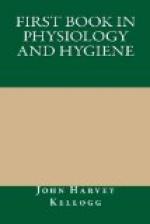18. An Experiment.—If you will weigh a piece of bone, then burn it in the fire for several hours, and then weigh it again, you will find that it has lost about one third of its weight. You will also notice that it has become brittle, and that it seems like chalk.
19. Why the Bones are Brittle.—The hard, brittle portion of a bone which is left after it has been burned contains a good deal of chalk and other earthy substances, sometimes called bone-earth. It is this which makes the bones so hard and firm that they do not bend by the weight of the body. When we are young, the bones have less of this bone-earth, and so they bend easily, and readily get out of shape. When we get old, they contain so much bone-earth that they become more brittle, and often break very easily.
20. A person’s height depends upon the length of his bones. The use of alcohol and tobacco by a growing boy has a tendency to stunt the growth of his bones, so that they do not develop as they should.
SUMMARY.
1. There are about two hundred bones in the body.
2. All together they are called the skeleton.
3. The skeleton is divided as follows:
a. The skull.
{ Ribs.
b. The trunk. { Breast-bone.
{ Pelvis.
{ Back-bone.
{ Collar-bone.
{ Shoulder-blade.
{ Upper arm-bones.
c. The arms. { Lower arm-bones.
{ Wrist.
{ Hand and fingers.
{ Thigh.
{ Knee-pan.
d. The legs. { Lower-leg bones.
{ Ankle, including heel-bone.
{ Foot and toes.
4. The bones are useful for support, protection, and motion.
5. The place where two bones join is called a joint.
6. The tough substance which covers the ends of many bones is called cartilage or gristle.
7. The joints are enabled to work easily by the aid of a fluid secreted for that purpose.
8. The ends of the bones are held together in a joint by means of ligaments.
9. Bones are about two thirds earthy matter and one third animal matter.
10. The use of alcohol and tobacco may prevent proper development of the bones.
CHAPTER XIX.
HOW TO KEEP THE BONES HEALTHY.
1. Composition of the Bones.—Our bones, like the rest of our bodies, are made of what we eat. If our food does not contain enough of the substances which are needed to make healthy bone, the bones will become unhealthy. They may be too soft and become bent or otherwise misshapen. This is one of the reasons why bread made from the whole grain is so much more healthful than that made from very fine white flour. In making fine white flour the miller takes out the very best part of the grain, just what is needed to make strong and healthy bones. Oatmeal is a very good food for making healthy bones.




